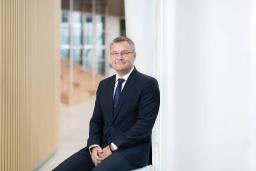HUS year 2023: From the CEO: First year of HUS Group improved personnel retention–challenges in access to care eased towards end of year
The first year of operations of the HUS Group was on the whole a positive experience. Personnel attraction and retention improved, and we managed to operate reasonably well within the confines of the new funding model. However, access to treatment remained problematic, even though the situation improved towards the end of the year.

The year 2023 was the first year of operations of the HUS Group. The hospital areas were discontinued at the New Year, and we adopted a new, profit area based organization model. The national reform of health, social and rescue services was the most extensive public administration reform ever undertaken nationwide, not just at HUS and in Uusimaa. In view of this, we may be quite satisfied with the year.
From accrual-based billing to budget framework
With the health and social services reform, HUS migrated from accrual-based billing to a budget framework model. We receive a certain amount of funding from the wellbeing services counties in Uusimaa and from the City of Helsinki, and this must cover our needs. This represents a major change from previous years.
Our financial deficit for 2023 was EUR 111 million, which of course is a large number. However, two thirds of that figure was due to circumstances beyond our control, such as the nursing pay decision and write-downs of supplies related to the Covid pandemic. In my view, the year was quite good financially, and we have every reason to be satisfied.
Access to treatment improved towards end of year
The waiting lists for access to treatment and care needs assessments remained long. These still show the after-effects of the Covid pandemic and of the industrial disputes of past years, but there were also challenges with personnel availability. We were able to reduce the waiting list for care needs assessments in the course of the year, and access to treatment likewise improved.
Waiting list growth halted, and the number of persons waiting for access to treatment began to decrease, but we are far away from completely eliminating the waiting lists. In order to permanently arrest the growth of the waiting lists, we need permanent additional funding, and dealing with the waiting lists we have now would require a one-off additional funding package. We will also need help from other health care sectors and from external services.
Increased personnel attraction and retention
We significantly boosted recruitment in the year under review, specifically targeting those units with the most critical personnel shortages. We were successful in this effort and increased the attraction of HUS as an employer, as witness the number of job applications received, for instance. This shows that we are doing things right.
We also invested in personnel retention to make our employees motivated. We continued to foster improved supervisor work and leadership and added resources to units where supervisors have large numbers of employees under them. We also experimented with performance-based pay in units with particularly long waiting lists. These efforts have been successful, and our staffing situation is now better than it was a year ago. Absences due to illness and exit turnover have also decreased. Of course, all this is just a good start, and we must continue our efforts on these lines.
Cooperation is key in 2024
We must continue to strengthen our partnership with the wellbeing services counties in Uusimaa and with the City of Helsinki in 2024. The special status of Uusimaa and how different the region is compared to the rest of the country call for robust cooperation between specialized medical care, primary health care and social services. Solutions, and hopefully additional funding, must be found to tackle the issue of access to treatment.
The preparations for the agreement on the Southern Finland collaborative area will also be an important feature of this year. This agreement will be a roadmap of how to collaborate across the entire southern region of Finland, with a population of 2.2 million.
Matti Bergendahl
Chief Executive Officer